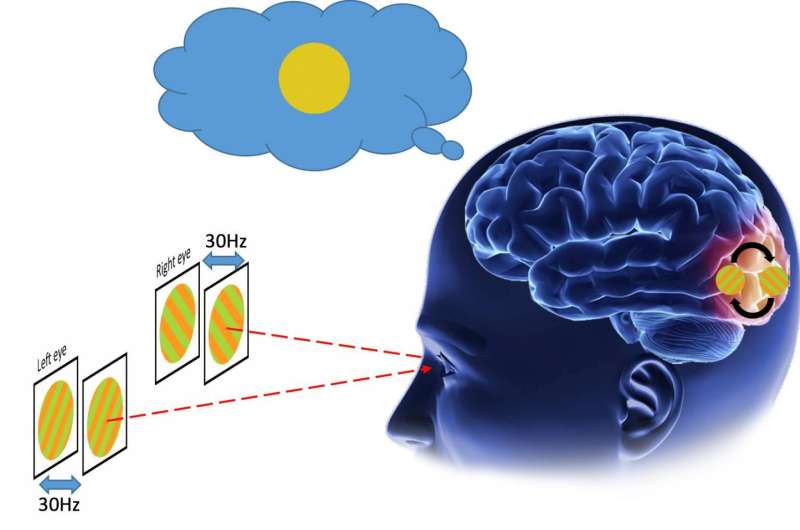Human early visual cortex subconsciously resolves invisible conflicts

Our visual system is constantly bombarded with complex optical information. The input information is often insufficient or ambiguous, leading to potentially conflicting interpretations about the structure of the physical world. The human brain applies impressive computational powers to resolve these ambiguities and generate a coherent perception almost instantly. Scientists are interested in how the human brain achieves this goal and what it might reveal about general brain function.
When two different images are separately presented to the matching retinal locations of both eyes, instead of seeing a mixed image, normal observers perceive a spontaneous alternation between the images. This striking visual phenomenon, called binocular rivalry, has been used as a tool by cognitive neuroscientists to study the brain mechanisms that resolve ambiguities to generate conscious perception. This is because in binocular rivalry, conscious experience changes while physical stimuli remain constant.
For the brain to engage the conflict resolution mechanism, an intuitive assumption is that the brain first "detects" the conflict. A central question is whether the conflict needs to be consciously detected for it to be resolved. In the case of binocular rivalry, in which the conflict exists between the two eyes, the question becomes whether binocular rivalry requires conscious awareness of the conflicting information between the two eyes. This is the question investigated in a study jointly conducted by Dr. Zhang Peng and Dr. He Sheng's research groups, including graduate student ZOU Jinyou, from the Institute of Biophysics of the Chinese Academy of Sciences, published online at PNAS on June 27, 2016. The research question is straightforward: If the conflicting features of the two eyes' images were invisible, leading to identical perceptual interpretations, would rivalry competition still occur?
The researchers used red-green chromatic gratings, presented in orthogonal orientations to the two eyes, thus producing interocular conflicts. However, the red-green stripes were rendered invisible by counterphase flickering of the pattern at 30 Hz. At this flickering rate, the red-green fused and both gratings were perceived as an identical uniform yellow disc. Although these stripes were invisible, researchers demonstrated that the orientation information was processed in the early visual cortex, but was not available to the parietal and frontal cortical areas.
In a series of creatively designed behavioral experiments, researchers revealed that although perceptually there was no difference between the two eyes' images, the invisible orientation conflict between the two eyes indeed induced rivalry competitions. An invisible grating presented to one eye produced rivalry competition with a low contrast visible grating presented to the other eye. Switching from a uniform field to a perceptually matched invisible grating, all without observers noticing any change, produced interocular suppression at approximately 200 ms after the onset of the invisible grating. Furthermore, experiments using briefly presented monocular probes revealed evidence for sustained rivalry competition between two invisible gratings during continuous presentations.
These findings show that the human brain initiates mechanisms, presumably in the sensory cortex with minimal involvement of the fronto-parietal cortex, to resolve conflicting information in visual input even when the conflicting information is not consciously perceived. Researchers conclude that visual competition could occur without conscious representation of the conflicting visual inputs. This forms an interesting and important contrast with early findings made by the same group, i.e., that focused attention is required for conflict resolution in the brain.
More information: Binocular rivalry from invisible patterns, PNAS, www.pnas.org/cgi/doi/10.1073/pnas.1604816113











.jpeg)

